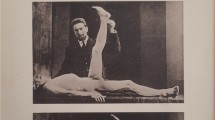Abstract
The “toe phenomenon” refers to the extension (dorsiflexion) of the great toe, which occurs instead of the normal flexion following stimulation of the foot sole. Its clinical significance was not fully appreciated until Joseph Jules François Félix Babiński (1857–1932) described it in 1896. In 1881, Ernst Strümpell (1853–1925) had described a continuous (tonic) extension of the big toe, a finding that years later the French neurologist Jean-Athanase Sicard (1872–1929) recognized as an equivalent of the “toe phenomenon”, also indicating pyramidal tract dysfunction. Previously, this phenomenon had been mentioned in patients only passingly and without providing a picture of it. In 1887, the German neurologist Adolph Seeligmüller (1837–1912) mentioned the tonic extension of the big toe among the characteristic clinical features of spastic infantile hemiplegia—a condition first described by the Austrian physician Moritz Benedikt (1835–1920) in 1868. Seeligmüller incorrectly attributed the tonic extension of the big toe to spastic contracture of the extensor hallucis longus muscle. However, he put great emphasis on this sign and considered it worth being illustrated. Adolph Seeligmüller therefore provided the very first graphic illustration of the (tonic) “toe phenomenon” in the medical literature. Of note, the first photographic illustration of this sign made by Babiński appeared only in 1900, when it had already been adopted by neurologists all over the world.


Similar content being viewed by others
Data availability
Not applicable.
References
Brigo F (2020) The Babiński sign: from “toes phenomenon” to “great toe phenomenon.” Med Hist 4(2):e2020006
Brigo F, Lattanzi S, Nardone R (2021) The Babinski sign in the first Italian reports. Neurol Sci. 2021. doi: https://doi.org/10.1007/s10072-021-05081-w
Hall M (1841) On the diseases and derangements of the nervous system. H. Baillière, London
Strümpell A (1881) Beiträge zur Pathologie des Rückenmarks. Arch Psychiatr Nervenkr 11:27–74
Strümpell A (1885) Traité de pathologie interne, vol II. Librairie F. Savy, Paris
Remak E (1839) Zur localisation der spinalen Hautreflexe der unterextremitaten. Neurol Centrabl 12:506–512
Galassi FM, Galassi S (2016) A case of Horton’s disease (with its potential neurological symptoms) depicted in a portrait by Andrea Mantegna. Neurol Sci 37:147–148
Brigo F, Caglioti F (2021) Babinski sign in the only existing sculpture by Leonardo. Childs Nerv Syst 37:1029–1031
Sellal F, Tatu L (2020) The Babinski sign in Renaissance paintings-a reappraisal of the toe phenomenon in representations of the Christ Child: observational analysis. BMJ 371:m4556
Hurwitz B (2021) The Babinski sign in Renaissance paintings: the fallacy of mis-framed observations. BMJ. 372:n574
Seeligmüller A (1887) Lehrbuch der Krankheiten des Rückenmarks und Gehirns sowie der allgemeinen Neurosen. Verlag von Friedrich Wreden, Braunschweig
Benedikt M (1868) Elektrotherapie. Tendler & Comp, Wien
Acchiote P (1911) Extension continue du gros orteil, signe de l’irritation permanente du faisceau pyramidal. Rev Neurol (Paris) 22:712–713
Sicard JA (1911) Extension continue du gros orteil. Signe de réaction pyramidale Rev Neurol 22:405–407
Winkler AS, Reuter I, Harwood G, Chaudhuri KR (2002) The frequency and significance of “striatal toe” in parkinsonism. Parkinsonism Relat Disord 9:97–101
Arendt C, Zierz S (2020) Adolph Seeligmüller (1837–1912). J Neurol. https://doi.org/10.1007/s00415-020-10268-w
Seeligmüller A (1883) Ueber syphilitsche Neuralgien Deut med Wschr 9:624–625
Arendt C, Zierz S (2020) Adolph Seeligmüller’s contribution to myotonia congenita Thomsen. Neuromuscul Disord 30:999–1004
Strümpell A (1880) Beiträge zur Pathologie des Rückenmarks. Archiv f Psychiatrie 10:676–717
Babinski J (1900) Diagnostic différentiel de l’hémiplégie organique et de l’hémiplégie hystérique. Gazette des Hopitaux 73:521–527
Acknowledgements
We are grateful to Paolo Benna, Neuroscience Department, Università di Torino, Turin, Italy; Giacomo Cattaino, Pordenone, Italy; Fedele Dono, Department of Neuroscience, Imaging and Clinical Science, “G. D'Annunzio” University of Chieti-Pescara, Chieti, Italy; Giuseppe Reale, Institute of Neurology, Università Cattolica del Sacro Cuore, Fondazione Policlinico A. Gemelli, Rome, Italy; Paolo Solla, Department of Neurology, University of Sassari, Italy; Giorgio Zanchin, Department of Neurosciences, University of Padua, Italy; and Henri Zenuni, Department of Systems Medicine, University of Roma Tor Vergata, Rome, Italy, on behalf of the Study Group on the History of Neurology of the Italian Neurological Society (Società Italiana di Neurologia, SIN), for their contribution to the final validation of the present manuscript and recommendations.
Author information
Authors and Affiliations
Consortia
Contributions
Francesco Brigo conceived and wrote the article; the other authors revised it critically for important intellectual content.
Corresponding author
Ethics declarations
Conflict of interest
The authors declare no competing interests.
Ethical approval
Not applicable.
Informed consent
Not applicable.
Additional information
Publisher's note
Springer Nature remains neutral with regard to jurisdictional claims in published maps and institutional affiliations.
Supplementary Information
Below is the link to the electronic supplementary material.
Rights and permissions
About this article
Cite this article
Brigo, F., Lorusso, L. & the Study Group on the History of Neurology of the Italian Neurological Society. Adolph Seeligmüller (1837–1912) and the first graphic illustration of the “toe phenomenon” (later called “Babiński sign”) in the medical literature . Neurol Sci 43, 2145–2148 (2022). https://doi.org/10.1007/s10072-021-05438-1
Received:
Accepted:
Published:
Issue Date:
DOI: https://doi.org/10.1007/s10072-021-05438-1




